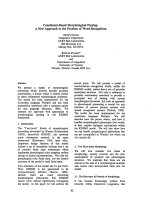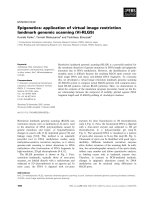Báo cáo khoa học: "AN APPLICATION OF AUTOfIATED LANGUAGE UNDERSTANDI;IG TECHNIQUES TO THE GENERATION OF DATA BASE ELEMENTS" potx
Bạn đang xem bản rút gọn của tài liệu. Xem và tải ngay bản đầy đủ của tài liệu tại đây (198.09 KB, 4 trang )
AN APPLICATION OF AUTOfIATED LANGUAGE UNDERSTANDI;IG TECHNIQUES TO THF GENERATION OF DATA BASE ELEMENTS
Georgette Silva, Christine Montoomerv. and Don Dwiggins
Operating Systems, Inc.
21031 Ventura Boulevard
Woodland Hills, CA 91364
This paper defines a methodology for automatically an-
alyzing textual reports of events and synthesizing
event data elements from the reports for automated in-
put to a data base. The long-term goal of the work
described is to develop a support technology for spe-
cific analytical functions related to the evaluation
of daily message traffic in a military environment.
The approach taken leans heavily on theoretical ad-'
vances in several disciplines, including linguistics,
computational linguistics, artificial intelligence,
and cognitive psychology. The aim is to model the
cognitive activities of the human analyst as he reads
and understands message text, distilling its contents
into information items of interest to him, and build-
ing a conceptual model of the information conveyed by
the message. This methodology, although developed on
the basis of a restricted subject domain, is presumed
to be general, and extensible to other domains.
Our approach is centered around the notion of "event",
and utilizes two major knowledge sources: (1) a model
of the sublanguage for event reporting which charac-
terizes the message traffic, and (2), a model of the
analyst-user's conceptualization of the world (i.e.,
a model of the entities and relations characteristic
of his world).
THE SUBLANGUAGE
The two sublanguage domains studied thus far consist
of descriptions of events involving aircraft activities
and launchings of missiles and satel]ites.
The source data are contained in the text portions of
military messages typical of these subject domains,
consisting of a report title summarizing a given event,
followed by one or more declarative sentences describ-
ing that event (and optionally, other related events).
Both the semantics and the syntax of these event de-
scriptions are constrained by two factors. One, by
the particular subject domain, and two, by the fact
that the events described are limited to what is ob-
servable and what should be reported according to a
reporting procedure. This results in a substantial
number of participial constructions of various types,
complex nominalizati~ns and agentless passives, as
well as a range of types of quantification, conjunc-
tion, complementation, ellipsis, and anaphora. The
sublanguage, although less extensive in its inventory
of syntactic constructions than event reports in
journalistic narrative, nevertheless contains certain
constructions which present challenging semantic pro-
blems. Such problems include the treatment of "re-
spectively" constructions, as well as certain types of
definite anaphora which not only transcend sentence
boundaries and, in some cases, even message boundaries,
but often are of the kind that have no explicit re-
ferent in the previous discourse.
Of the two languages studied thus far, the discourse
structure of the missile and satellite reports is con-
siderably more complex than that of air activities.
While in air activities reports the description of a
given event is often completed within a single sentence
(e.g., a particular aircraft penetrated enemy airspace
at a specific location and a specific time), in missile
and satellite reports the complete specification of the
properties of an event and of the object(s) involved
more frequently requires several sentences, and not un-
commonly, several messages. Thus, a report on some
launch operation can consist of an initial, rather
skeletal statement, followed by one or more messages
received over a period of time, which update the prev-
ious report, adding to and sometimes changing previous
specifications. The boundaries of a discourse relevant
to a single event, then, can range from a single sen-
tence to several messages. The problem of assembling
the total mental "picture" relating to any given event
can only be approached on the discourse level.
Any message may contain descriptions of more than one
event. These events may be connected in some way, or
totally unrelated (e.g., a summary), Our approach to
this problem is to describe the meaning content of the
message in terms of a "rlessage Grammar" in which the
"primitives" are event classes, and the relations are
discourse-level relations. The latter may be optional
or obligatory and determine the connectivity or non-
connectivity between events.
THE WORLD rIODEL
A particular world of discourse is characterized by a
collection of entities, including their properties and
the relations in which they participate. We define a
world model in terms of abstract data structures called
"templates", which resemble linguistic case frames.
Each template describes a class of entities in terms
of those properties which are normally associated with
that class in a particular domain. A template thus re-
flects the information user's conceptualization of the
domain, i.e., his view of what that class of entities
involves. In the domains under investigation there are
templates for classes of objects (aircraft, missiles),
classes of events (flights, launchings), classes of re-
lations (temporal, causal), and other concepts such as
time and date. A template represents an n-ary relation,
where the n-ary relationship is named by a predicate
symbol (e.g., Precede (Eventl, Event2), Enroute (Object,
Source, Destination, Time, etc.)).
The templates are the basic data objects of an Event
Representation Language (ERL), an experimental language
written to explore the use of "templates" as a knowledge
representation technique with which to build language
understanding systems for message text analysis.
The Event Representation Language is implemented in a
subset of Prolog, a formalism using a clausal form of
logic restricted to "Horn" clauses. Horn clauses can be
given both a declarative and a procedural intrepretation
and are therefore very well suited for the expression of
concepts in the Event Representation Language. The
basic computational mechanism of Prolog is a pattern
matching process ("unification") operating on general
record structures ("terms"of logic).
Templates are encoded as "construct" clauses. For ex-
ample, the DEPLOY template, which is informally
This' research was sponsored by the Air Force Systems
Command's Rome Air Development Center, Griffiss Air
Force Base, New York.
95
Table
I.
Informal Description of the DEPLOY Concept
I
I
Descriptive Elements
)
Procedural Elements
t
I
":;;Z 7: )
IOescriptor Filler Specification -L_ i I for .
,
/OPT;
, filling smots
' : Y
:
I
, Logical Subject OBL Construct 'Aircraft'
Object
: noun
phrase
)
(+acft)
I
I
Destination: PP:'to'+ NP(+loc) OBL
~. _ _ .~
template from logical
subject
Search VMODS list
for appropriate
prepositional phrase
!
1
,+ + -,
:
Search VMODS list
• Aov~ time reT)
Time 9 ao {a, .4 ha. OPT , for appropriate
~" ~" '~""~ )constituent
NP( ti,.~y . ,
Table 2. Prolog Representation of DEPLOY Template
construct ('DEPLOY', s(Subj,Vbgr,Obj,Compl,Vmods),[OB1 ,S1 ,LZ,DTG]):-
object(Subj,OB1),
desttnation(Vmods,D1),
construct('DTG' ,VmodsoDTG).
~l
Table 3. A "Destination" Clause
desttnation(Vmods, slot('DESTINATION=',S1ot)):-
flll-slot(Vmods,['TO'],'LOC',Slot).
96
represented in Table 1 in a simplified form, is encoded
as in Table 2.
The head of the "construct" clause has three arguments:
a template name, the name of the syntactic constituent
which serves as the context which is searched in an
attempt to find fillers for the descriptor slots of the
temp]ate in question, and a third argument which re-
presents the output of the procedure, i.e., the in-
stantiated slots.
The body of the "construct" clause consists of three
"goals" corresponding to the three slots of the DEPLOY
template shown in Table 2. These three goals are them-
se]ves defined as procedures, which seek fillers for
the descriptor slots they represent.
For example, the "destination" slot in the "construct"
procedure for DEPLOY is written as in Table 3.
This representation has certain advantages, among which
we might mention the following two: (1) if additional
information needs to be associated with a particular
predicate, this can be done simply by adding another
clause; and (2), Prolog provides a uniform way of re-
presenting structures and processes at several levels
of grammatical description: syntactic structures,
syntactic normaIJzation, description of objects, de-
scription of events, and description of text-leve] re-
lations.
THE UNDERSTANDING PROCESS
The formal definition of the sublanguage currently
takes the form of an ATN grammar. The parser takes a
sentence as input and produces a parse tree. The parse
is input to the ERL "machine", which uses templates
for the interpretation of the input and produces "event
records" as output. Event records can be viewed as
"instantiated" templates. They are event-centered data
structures in which the information conveyed by the in-
put can be viewed from the perspective of time, loca-
tion, type of activity, object(s) involved, etc. These
event records constitute the "extensional" data base
which serves as a support tool for higher-level analy-
tical functions in a decision-making environment.
The computer program which embodies this approach to
natural language understanding is written in FORTH,
Pro]og, and SrIOBOL4, and runs on a PDP l]/45 under
the RSX operating system.
The major part of the system was built in the program-
ming language FORTH, which is an interactive, incremen-
tal system with a low-level semantics which the user
can easily and quickly extend. This allowed the rapid
development of the ATN language and control scheme, as
well as the support scheme for the execution of the ERL
algorithms. These are written in Prolog, which is as
mentioned above a language that is well suited to the
specification of templates and the algorithms for in-
stantiating them. For ease of implementation, the
compiler for the subset of Prolog utilized in this
application was written in S~OBOL4.
The use of FORTH and the Prolog formalism allowed fair-
ly easy development of the system even without the
powerful structure manipulation capabilities of a lan-
guage like LISP. The major impact of the minicomputer
environment was felt near the completion of system de-
velopment, when the combined programs nearly filled
the available 64K byte address space. This has been
mitigated somewhat by moving the working data to a form
of virtual memory which is supported by FORTH, and by
overlaying the grammar code with the interpretation
code.
9"/









